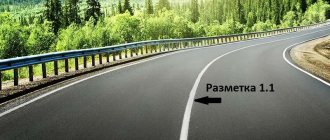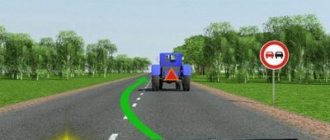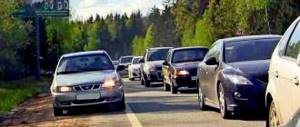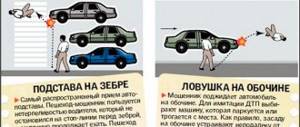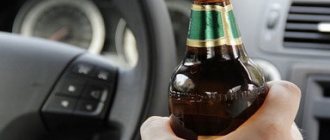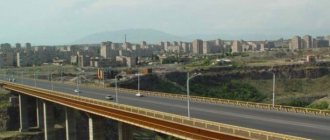Young drivers often have many questions that somehow never even occurred to them before, when their whole life was spent on two legs. One of the most common - what is the difference between a single dividing strip and a double solid one?
Concept of double and single solid lines
Some drivers face questions about the median lines. Even after completing the courses and having learned all the rules, car enthusiasts do not fully understand the difference between the two concepts. The problem lies in the minimum amount of time allocated for this topic.
Note the difference between the two restrictions:
- Single line - used for marking roads and highways where there are only two lanes for multi-directional traffic (one in each direction).
- Double line – used on wide highways and city roads with four or more lanes. In most cases, such lines can be found on country roads and wide city roads, which provide several oncoming and passing lanes.
Wide highways with several oncoming lanes can significantly increase the space for overtaking, detours and other maneuvers.
This is interesting: 3 violations for which inspectors often punish more severely than expected
Single and double continuous according to the Code of Administrative Offenses
Most drivers have questions about markers on the road, even though they have all completed driving courses. The reason for this misunderstanding is the minimal amount of time devoted to this topic.
It is therefore worth repeating that:
- Single solid (1.1) is applied on roads with only two lanes (oncoming and passing).
- Double solid (1.3) is applicable on roads with 4 or more lanes. It can be seen on wide highways located in cities and beyond, which provide several passing and oncoming lanes, which provides enough space for various maneuvers.
See also:
Is it legal to cross the solid line at the edge of the roadside?
When to use single markup
One of the variations of road markings is single marking, or single solid line, or 1.1 marking.
Single markings are placed not on the edge of the roadway, but exclusively inside it.
Markup 1.1. used in four variants:
For the purpose of marking traffic lanes on roads with several lanes in both directions (two or three)
A single solid line separates two-lane and three-lane roads to separate traffic flows in different directions.
On a three-lane road, such markings also prohibit driving into oncoming traffic and indicate that you should only move in your own lane.
In addition, single markings are drawn on dangerous sections of the road:
- sharp turns when visibility is limited;
- approaching intersections, railroad crossings, pedestrian crossings, or bicycle paths;
- with a lane for minibuses or taxis when access to it is prohibited.
A single line is placed to indicate traffic on a road with 2 and 3 lanes in the same direction
Another quite common case of using a single solid line is when it is applied to a road with a large number of stripes to designate a lane of traffic in a single direction. At the same time, vehicles are prohibited from changing from one lane to another when it is unsafe to do so.
Also, the need for markings 1.1 arises when indicating dangerous sections of the road.
Marking 1.1 for marking parking areas
Such a line is placed on special sites that are intended for parking one vehicle, as well as in parking lots near the sidewalk.
In this case, the markings highlight the very “framework” within which you need to park your car. The driver must follow the parking rules and not leave the car across the designated parking space.
Otherwise, he will grossly violate the rules and, at best, an administrative penalty will be imposed on him.
“Single continuous” for areas where entry is prohibited
A single line is also used in very specific situations: to limit a safe island, a directional island, and other situations if there is a need to prohibit entry to such areas.
What are the dangers of crossing double solid markings?
Entering the lane of oncoming traffic with the intersection of the studied marking line, according to Art. 12.15 of the Code of Administrative Offenses, punishable by:
- Deprivation of the right to drive a motor vehicle. The protocol drawn up at the place of arrest is sent to the court, which makes a decision to confiscate the driver’s license.
- A fine. Issued if there are no aggravating circumstances or the offense is recorded by a traffic camera.
In cases where the double solid marking line is crossed, but the car does not drive into oncoming traffic, then, according to Art. 12.16 of the Administrative Code, the driver can receive a fine and not be afraid of being left without a license. The amount of the fine in each case depends on the degree of violation:
- The fine will be 1,500 rubles if the driver turns or turns around through a solid road.
- You can lose your license for 4-6 months for driving into the oncoming lane. An alternative to deprivation is a fine of 5,000 rubles. Aggravating circumstances that influence the court's decision are considered to be: driving onto oncoming tram tracks, crossing a double solid line for overtaking, driving after turning into the oncoming lane.
- A fine of 500 rubles. It is punishable to leave courtyard areas by turning left and crossing. According to traffic rules, in this case it is necessary to turn right.
- Rebuilding from the second row with a continuous intersection - 1,500 rubles.
- From 1000 to 1500 rub. you will have to pay if the driver turns around the limit line while avoiding an obstacle.
- Overtaking by crossing a double solid line (a double broken line marking could have been at the beginning of the maneuver) - confiscation of the driver's license or a fine of 5,000 rubles.
- Lose your rights for up to six months or pay 5,000 rubles. possible for hitting the limit line. It doesn’t matter how many wheels hit the marking line. The degree of responsibility of the driver is determined by the traffic police.
- Changing lanes at an intersection with a double solid intersection (according to the traffic rules, the punishment is not only for hitting a marking, but also for maneuvering at an intersection) - 1,500 rubles.
From the point of view of the Administrative Code, is there a difference in the number of marking lines
There is practically no significant difference between single solid and double. Markings 1.1 are drawn on roads with no more than 2 lanes, and markings 1.3 on roads with several lanes in both directions.
Crossing a double marking line does not mean that the penalty will be double the fine. In the traffic rules there is no such concept as “crossing a single or double continuous marking line”, there is only “entering the lane of oncoming traffic.” That is, crossing a single or double solid line indicates entering the oncoming lane.
It is strictly forbidden to cross both of these markings. Even if you want to make a maneuver such as overtaking or you need to go around an obstacle.
For such a violation, the driver is punished with a fine of five thousand rubles or deprivation of the right to drive a vehicle for a period of 4 to 6 months. If the violation is repeated, the deprivation will be for a year.
When making a U-turn or turning, crossing a single solid or double solid line, it is punishable by a fine of 1 thousand to 1.5 thousand rubles.
Turning, turning around and entering the oncoming lane is allowed only if the solid line has turned into a broken line, and if we are talking about a double solid line, but the dotted line should be on your side of the road.
All landmark lines on roads are invented and written down for a reason. In no case should they be ignored, and every driver, pedestrian or cyclist should know what they mean and how to behave in a given situation, then everyone will be able to protect themselves and other people from road accidents and reduce the risk of an accident.
What is the difference between single solid and double solid?
If you see one solid road, it means you are moving on a road where there are only two lanes - in one direction and the other, as you might guess.
If the road is double solid, it means you are driving on a highway with at least four lanes (and there may be more). In this case, there are at least two oncoming lanes.
Now regarding the punishment for crossing solid roads. Is there a difference in this case? It all depends on what kind of violation the driver committed. If the driver of a vehicle crosses a solid line, he will lose his driver's license without exception. Rights are taken away for a period of 4 months to six months.
However, if the driver turns left and turns around, causing the crossing of markings to occur in any case, the driver of the vehicle will only get off with a fine - the amount is not the most serious.
If we are talking about a wide road with several lanes, where there are 2 lines in one direction, can drivers change lanes from one to the other? This is also easy to understand from the markup. When the driver sees a single solid line, it means there is a ban on changing lanes.
Purpose of different types of markup
In order to understand, you need to understand in which cases one continuous line is applied to the road surface, and in which – two. Both types of lines are regulated by Appendix 2 to the Traffic Regulations. The first markup option is numbered 1.1, and the second is numbered 1.3.
A single solid line (1.1) is designed to separate traffic flows moving in opposite directions. In addition, it marks the boundaries of lanes in dangerous sections of the roadway, as well as the edge of the roadway and parking spaces.
Double continuous markings (1.3), like single ones, serve to separate traffic flows moving in opposite directions. It is only used mainly on roads with four or more lanes. Marking 1.3 is applied to a two- or three-strip fabric if the width of the stripes exceeds 3.75 m.
So we see that the basic function of these two types of lines is the same. Exactly what marking will be applied depends only on the number of stripes and their width.
Where are these lines
According to the traffic rules, one continuous one (marked in the standard as 1.1) is applied on dangerous roads. It is needed to separate active traffic flows.
This stripe is often located at the edges of the road; it can be not only white, but also yellow. In this case, the strip indicates areas where you cannot stop, even for a short period. Regardless of the color, the rules do not allow driving beyond one continuous line.
Found on highways near populated areas. Markings separate lanes for passing vehicles and can indicate the center of the road.
The double line in the rules is indicated by the numbers 1.3. It is designed to separate the flow of cars moving in different directions in two-way traffic. Double markings are found on wide roads where the lanes are more than 375 cm.
Most often, double solid is used on highways and in large cities with heavy traffic. Such markings are common on wide roads where there is plenty of room for overtaking or in dangerous areas.
